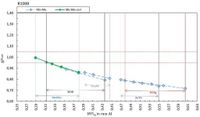In an important advancement for breast imaging quality control, a recent study published in Scientific Reports has highlighted how the choice of anode/filter combinations in X-ray multimeter (XMM) software can significantly affect the accuracy of critical dosimetric measurements. The research, conducted by E. Salomon and colleagues at the International Atomic Energy Agency (IAEA), investigates the impact of this selection on air kerma, half-value layer (HVL), and tube voltage measurements—essential parameters that help ensure patient safety during imaging.
According to the study, one of the paramount goals of breast imaging systems involving ionizing radiation is to maintain high diagnostic confidence while ensuring that patient radiation doses remain at acceptable levels. Accurate dosimetric measurements are vital, especially as medical professionals increasingly engage in patient-specific optimization of radiation quality and risk assessment for radiation-induced conditions.
The study rigorously compared readings from eight commercially available XMMs against established reference values for five different anode/filter combinations and a spectrum of tube voltages between 25 to 35 kV. The results demonstrated that when the anode/filter combination selected in the XMM software matched that of the X-ray beam, the deviation in air kerma was a manageable 19%, while tube voltage deviations were at 9% and HVL at 10%. However, discrepancies skyrocketed when the combinations did not align—in some cases, deviations peaked at 31% for air kerma, 44% for tube voltage, and a staggering 45% for HVL.
The authors of the article succinctly concluded, "The appropriate selection of the anode/filter combination in the XMM software is crucial for obtaining reliable measurement results." This points toward a systemic problem that could lead to incorrect dosimetric calculations, potentially jeopardizing patient safety by under- or overestimating radiation exposure during mammographic procedures.
The rationale behind focusing on this specific area stems from the complex array of anode/filter combinations used in clinical settings today. Variability in calibration options can lead to regularly occurring errors, which are often exacerbated by limited choices available within the software of XMMs. Clinical staff may inadvertently select incorrect combinations, leading to significant inaccuracies that could undermine the quality of the imaging and result in adverse outcomes for patients.
As part of the broader context, the ability to accurately record and monitor air kerma, HVL, and tube voltage is reinforced by international standards and the evolving landscape of imaging technologies. The increasing complexity of breast imaging modalities, which include mammography, tomosynthesis, and contrast-enhanced techniques, further necessitates stringent quality assurance measures and robust calibration procedures.
The study also found that interpolating calibration coefficients between varying radiation qualities is not recommended. Such practices could misrepresent the radiation exposure due to the considerable variances in measurement outcomes based on the anode/filter selections implemented within the XMM software. As the authors emphasize, maintaining strict adherence to calibration procedures is paramount for ensuring the reliability of dose estimates which, in turn, guides clinical decision-making.
This comprehensive investigation serves as a clarion call to the medical physics community, underlining the need for better calibration protocols and more user-friendly software features that facilitate accurate selection of anode/filter combinations. With the potential to positively impact patient care, the study's findings are anticipated to shape future guidelines for quality assurance in digital breast imaging.
As breast imaging continues to evolve, future research efforts should focus on developing standardized calibration procedures that consider the broad range of anode/filter combinations used in clinical practice. Such initiatives could improve the reliability of XMMs and strengthen the foundation of patient safety measures across healthcare settings.
In conclusion, ensuring rigorous quality control for X-ray systems, backed by reliable measurement techniques and protocols, remains a top priority for the health physics community. The implications of flawed dosimetric measurements extend beyond technical errors—they have real consequences for patient welfare, making the findings of this study vital to advancing the field.

